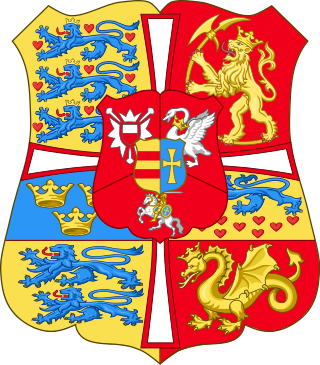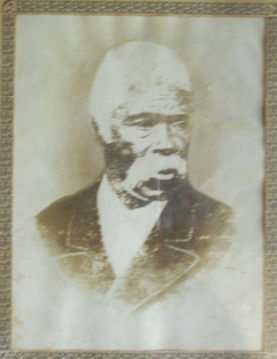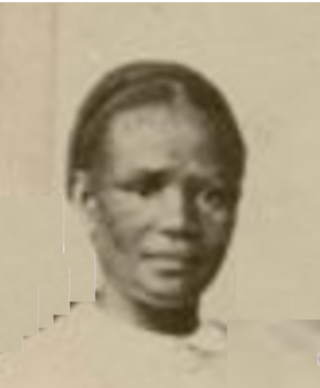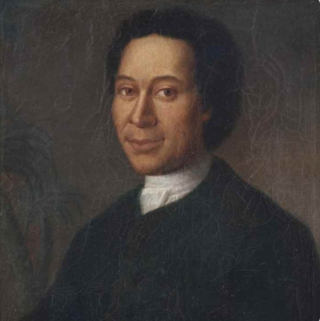
Ulrik Frederik Gyldenløve, Landgrave of Laurvig was Governor-general of Norway from 1664–1699. He was the leading general in Norway during the Scanian War, whose Norwegian leg is conventionally named the Gyldenløve War after him. In Norway he was also the Landgrave of Laurvig.

Louise Augusta of Denmark and Norway was the daughter of the Queen of Denmark-Norway, Caroline Matilda of Great Britain. Though officially regarded as the daughter of King Christian VII, it is widely accepted that her biological father was Johann Friedrich Struensee, the king's royal physician and de facto regent of the country at the time of her birth. She was referred to sometimes as "la petite Struensee"; this did not, however, have any effect on her position.

Swedish overseas colonies consisted of the overseas colonies controlled by Sweden. Sweden possessed overseas colonies from 1638 to 1663, in 1733 and from 1784 to 1878. Sweden possessed five colonies, four of which were short lived. The colonies spanned three continents: Africa, Asia and North America.
Anthony Coucheron was an engineering officer. Coucheron played an important role in the history of Norwegian and Danish fortifications. As Sweden grew to be a great power in the 17th century, there were frequent wars in the Baltic region, and conflict was common along the borders between Sweden & Denmark-Norway. Easy invasions routes from Sweden were fortified on the Danish-Norwegian border with new or upgraded fortresses during this period, effectively establishing the modern borders between Norway & Sweden. Anthony Coucheron played a major role in fortification of the border, both in Norway and Denmark in addition, he participated with honor in combat during the Gyldenløve War.

The Swedish Gold Coast was a colony of the Swedish Africa Company founded in 1650 by Hendrik Carloff on the Gulf of Guinea in present-day Ghana in Africa. Under foreign occupation for much of its existence, it disappeared for good in April 1663 when it became part of the Dutch Gold Coast.

Osu Castle is a castle located in Osu, Ghana on the coast of the Gulf of Guinea in Africa.
Christian Schiønning was a governor of the Danish Gold Coast, a Danish Crown Colony. He governed from the colony's capital, Fort Christiansborg, from 15 April 1807 to 1 March 1817.

Hovdala Castle is a castle in Hässleholm Municipality, Scania, in southern Sweden. Its oldest visible parts date from the early 16th century although the original construction dates back to at least the early 12th century.
Conrad Crull was the second governor of the Danish Gold Coast from 1674 to 1677. He governed the Danish Gold Coast from Fort Friedensburg (Frederiksborg).

Jens Toller Rosenheim, was a Norwegian nobleman, jurist and official.
Events from the year 1766 in Denmark.

Hendrik Carloff, Caerloff or Caarlof was an adventurer and slave trader active in the 17th century. Carloff began his career as a cabin boy but rose to become a commander and governor appointed by the Dutch West India Company and Danish or the Swedish Africa Company on the Gold Coast. Between 1676 and 1677, he was Governor of Tobago.

Fort Frederiksborg, later Fort Royal, was a Danish and later English fort on the Gold Coast in contemporary Ghana. It was built in 1661, with the approval of the King of Fetu, a few hundred yards from Cape Coast Castle, which was at that time in Swedish hands, on Amanfro Hill. Along with several other castles and forts nearby, Fort Frederiksborg was inscribed on the World Heritage List in 1979 because of its testimony to European economic influence on West Africa and the Atlantic slave trade.
Erik Tylleman was an Opperhoved of the Danish Gold Coast, a Danish Crown Colony. He governed from the colony's capital, Fort Christiansborg. Tylleman was the first Danish Governor who reigned in the United Gold Coast in 1698. The Danish Gold Coast was established on the eastern Gold Coast.

Alexander Worthy Clerk was a Jamaican Moravian pioneer missionary, teacher and clergyman who arrived in 1843 in the Danish Protectorate of Christiansborg, now Osu in Accra, Ghana, then known as the Gold Coast. He was part of the first group of 24 West Indian missionaries from Jamaica and Antigua who worked under the aegis of the Basel Evangelical Missionary Society of Switzerland. Caribbean missionary activity in Africa fit into the broader "Atlantic Missionary Movement" of the diaspora between the 1780s and the 1920s. Shortly after his arrival in Ghana, the mission appointed Clerk as the first Deacon of the Christ Presbyterian Church, Akropong, founded by the first Basel missionary survivor on the Gold Coast, Andreas Riis in 1835, as the organisation's first Protestant church in the country. Alexander Clerk is widely acknowledged and regarded as one of the pioneers of the precursor to the Presbyterian Church of Ghana. As a leader in education in colonial Ghana, he designed curriculum and pedagogy, co-establishing with fellow educators, George Peter Thompson and Catherine Mulgrave, an all-male boarding middle school, the Salem School at Osu in 1843. In 1848, Clerk was an inaugural faculty member at the Basel Mission Seminary, Akropong, now known as the Presbyterian College of Education, where he was an instructor in Biblical studies. The Basel missionaries founded the Akropong seminary and normal school to train teacher-catechists in service of the mission. The college is the second oldest higher educational institution in early modern West Africa after Fourah Bay College in Freetown, Sierra Leone which was established in 1827. Clerk was the father of Nicholas Timothy Clerk, a Basel-trained theologian, who was elected the first Synod Clerk of the Presbyterian Church of the Gold Coast from 1918 to 1932 and co-founded the all boys’ boarding high school, the Presbyterian Boys’ Secondary School established in 1938. A. W. Clerk was also the progenitor of the historically important Clerk family from the suburb of Osu in Accra.

Andreas Riis was a Danish minister and pioneer missionary who is widely regarded by historians as the founder of the Gold Coast branch of the Basel Evangelical Missionary Society. A resident of the Gold Coast from 1832 to 1845, Riis played a critical role in the recruitment of 24 West Indian missionaries from Jamaica and Antigua in 1843 to aid the work of the mission in formal education, agriculture and the propagation of the Gospel in colonial Ghana. As the first Basel missionary in Akropong in 1835, he laid the groundwork for the first mission house, eventually resulting in the founding of the first Christian church there which later became the Christ Presbyterian Church, Akropong.

Catherine Elisabeth Mulgrave also Gewe was an Angolan-born Jamaican Moravian pioneer educator, administrator and missionary who accompanied a group of 24 Caribbean mission recruits from Jamaica and Antigua and arrived in the Danish Protectorate of Christiansborg, now Osu, Accra in Ghana in 1843. Mulgrave was a leading figure in pedagogy and the education programme for girls in both Jamaica and on the Gold Coast. She was the Basel Mission’s first female teacher active on the Gold Coast. Under the auspices of the society, she played a pioneering role in the Christian women's ministry of the Protestant movement in colonial Ghana. Catherine Mulgrave was also one of the first African woman teachers in the missionary educationalist system in Africa.

Christian Jacob Protten also Christian Jakobus Africanus Protten or Uldrich was a Euro-African Moravian missionary pioneer, linguist, translator and educationalist-administrator in Christiansborg on the Danish Gold Coast in the eighteenth century. The first recorded grammatical treatise in the Ga and Fante languages was written by Protten and published in Copenhagen in 1764.












